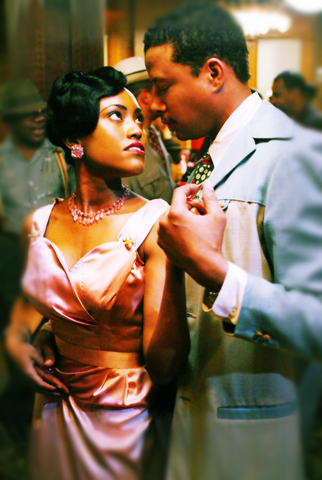Holly Golightly’s cocktail party in Breakfast at Tiffany's.
Dinner in Babette’s Feast.
The conga line, danced to Banana Boat Song in Beetlejuice.

PHOTO COURTESY OF HBO
The toga party in Animal House.
Some parties in movies are so inviting that viewers wish they could leap into the frame and join the madness. Lackawanna Blues opens with just that kind of evening: guests are drinking, eating and dancing at Nanny’s Friday night fish fry with the kind of infectious laughter and physical abandon that only people with hard lives can muster. This HBO film, to be shown Tuesday at 10pm, is set in a poor neighborhood of Lackawanna, New York and begins in 1956, a time when, as the narrator puts it, segregation forced blacks “to make their own heaven on Earth.’’
The jukebox in the parlor plays Boogie Woogie Country Girl by Big Joe Turner, as people teem through the house, dancing, chatting, smoking, drinking and eating under the hospitality of Rachel Crosby (S. Epatha Merkerson), an earth mother landlady who goes by the name of Nanny and sometimes Mama. When she is summoned to help a tenant who suddenly goes into labor, Nanny’s much younger husband, Bill (Terrence Dashon Howard), sneaks off to have sex with a party guest in the front seat of a car. The camera keeps switching from their lovemaking to the impromptu delivery, juxtaposing the girl’s screams of pleasure and the mother’s screams of pain until they meld into one.
It’s the fanciest scene in a film that is actually very simple: Lackawanna Blues, which originated as an autobiographical one-man show by Ruben Santiago-Hudson, consists of a string of vignettes paying tribute to the woman who raised him and took care of the misfits and misunderstood drifters in her community.
The film is a Hallmark movie with better music, an Under Milk Wood of segregation. But its poignancy is less in the portrait of a caring, nurturing woman than in its evocation of a lost world: a poor, rough, often violent neighborhood that held people together only to fall apart and vanish, closed down and boarded up, in the urban flight of the 1960s and 1970s.
And that window into a small, not particularly noteworthy moment in recent American history is rare, which helps explain the high-octane names behind the project: it was directed by George C. Wolfe; Halle Berry is one of the executive producers; Mos Def plays a bandleader and performs some of the music (his version of Louis Jordan’s Caldonia is reason enough to see the film); Louis Gossett Jr., Macy Gray and Jeffrey Wright play eccentric boarders; Liev Schreiber has a fleeting cameo as a disapproving social worker; Rosie Perez has an equally small role as a friend of Nanny’s; and Jimmy Smits plays the father of the boy Nanny takes in as her own.
The film has moments of sadness and heartache, and many treacly ones, hammered home by the blind singer Robert Bradley crooning the blues on sidewalks and backdoor stoops, but Lackawanna is at its best when it captures the fleeting joys of lost days. And one irresistible pleasure is the music and dancing at Maxie’s nightclub as the band plays Destination Love.
Lackawanna Blues premiers on HBO on Tuesday at 10pm.

May 26 to June 1 When the Qing Dynasty first took control over many parts of Taiwan in 1684, it roughly continued the Kingdom of Tungning’s administrative borders (see below), setting up one prefecture and three counties. The actual area of control covered today’s Chiayi, Tainan and Kaohsiung. The administrative center was in Taiwan Prefecture, in today’s Tainan. But as Han settlement expanded and due to rebellions and other international incidents, the administrative units became more complex. By the time Taiwan became a province of the Qing in 1887, there were three prefectures, eleven counties, three subprefectures and one directly-administered prefecture, with

It’s an enormous dome of colorful glass, something between the Sistine Chapel and a Marc Chagall fresco. And yet, it’s just a subway station. Formosa Boulevard is the heart of Kaohsiung’s mass transit system. In metro terms, it’s modest: the only transfer station in a network with just two lines. But it’s a landmark nonetheless: a civic space that serves as much more than a point of transit. On a hot Sunday, the corridors and vast halls are filled with a market selling everything from second-hand clothes to toys and house decorations. It’s just one of the many events the station hosts,

Two moves show Taichung Mayor Lu Shiow-yen (盧秀燕) is gunning for Chinese Nationalist Party (KMT) party chair and the 2028 presidential election. Technically, these are not yet “officially” official, but by the rules of Taiwan politics, she is now on the dance floor. Earlier this month Lu confirmed in an interview in Japan’s Nikkei that she was considering running for KMT chair. This is not new news, but according to reports from her camp she previously was still considering the case for and against running. By choosing a respected, international news outlet, she declared it to the world. While the outside world

Through art and storytelling, La Benida Hui empowers children to become environmental heroes, using everything from SpongeBob to microorganisms to reimagine their relationship with nature. “I tell the students that they have superpowers. It needs to be emphasized that their choices can make a difference,” says Hui, an environmental artist and education specialist. For her second year as Badou Elementary’s artist in residence, Hui leads creative lessons on environmental protection, where students reflect on their relationship with nature and transform beach waste into artworks. Standing in lush green hills overlooking the ocean with land extending into the intertidal zone, the school in Keelung